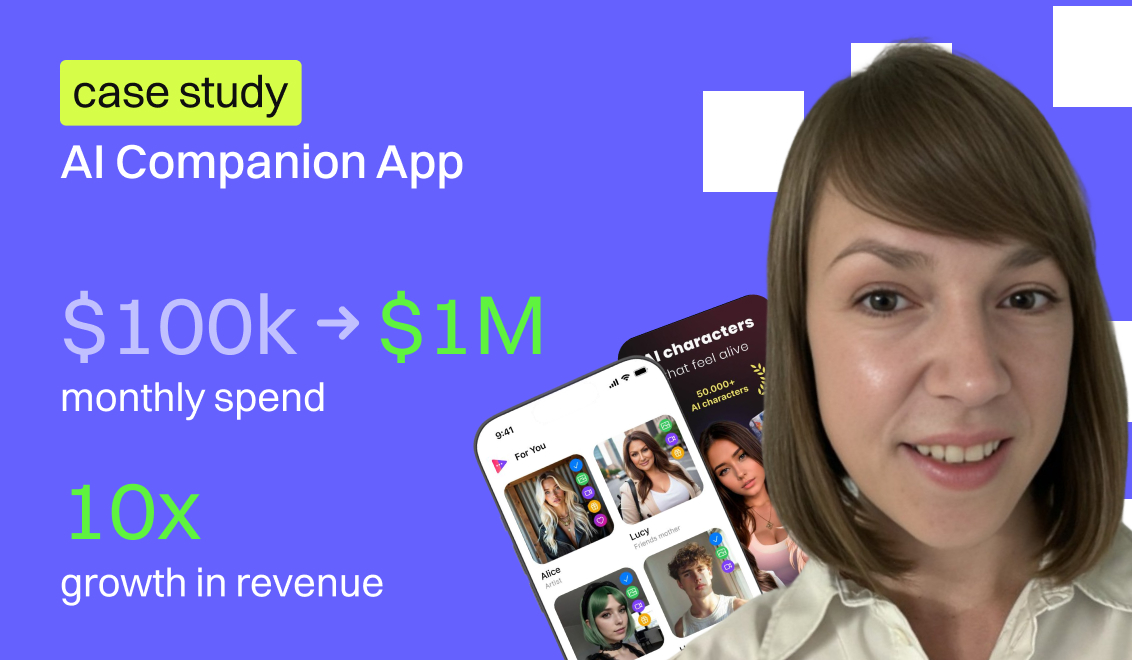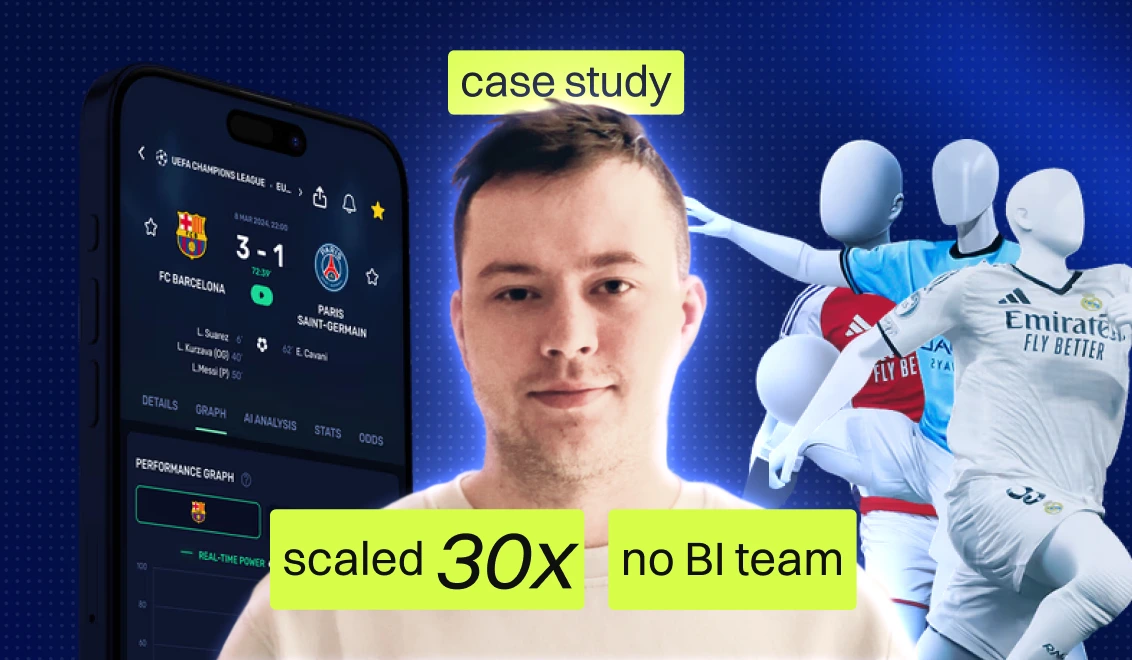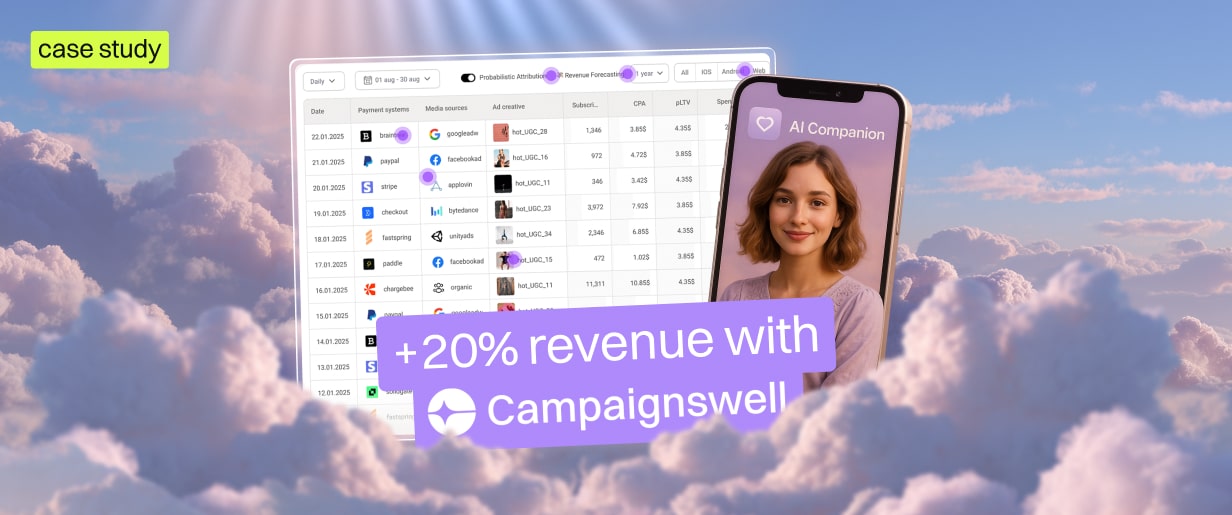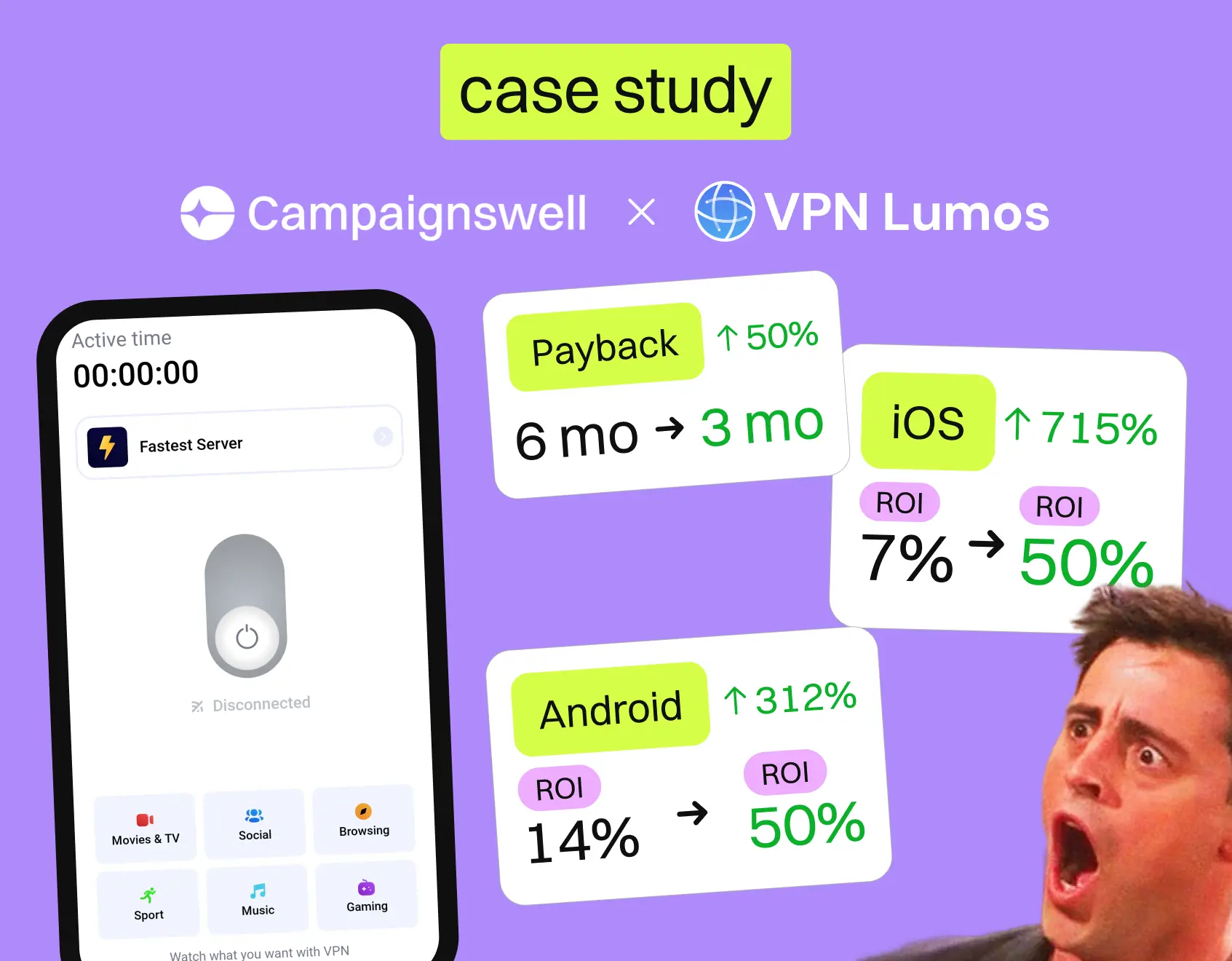How predictive LTV helped this app studio triple UA spend without losing sleep

At this multi-vertical mobile app studio, the day didn’t begin with coffee or a team sync, it began with CSV exports, browser tabs, and the quiet dread of manual calculations. Spend data from Meta in one window, trial analytics from Apphud in another, subscription receipts from Apple somewhere deep in a folder. If the founder and growth lead wanted to know how a campaign was performing, she had to piece it all together by hand, line by line, sheet by sheet.
For a long time, the company's growth has come from smart product bets and strong organic distribution. But as paid acquisition became more essential and the competition more aggressive, they realized their existing setup wasn’t built for the kind of precision and speed they now needed.
Every tool promised to help them grow — BI, MMPs, dashboards, all the usual suspects. But somehow, none of it actually helped when it came to real decisions. Campaign performance was buried under mismatched dashboards. Attribution was laggy. LTVs lived in spreadsheets. Every test meant hours of prep and a good dose of guesswork. Campaigns got paused too early. Bold ideas were shelved. Scaling felt risky not because the product wasn’t ready, but because the data wasn’t.
If you've ever found yourself triple-checking ROI in Excel before greenlighting spend, this one will hit home. That was daily life for this team until Campaignswell showed up and rewrote the playbook.
Our client isn’t a giant studio with layers of teams and endless roadmaps. It’s a small, fast-moving crew that’s launched 16+ apps across lifestyle, productivity, utilities, and music tools, like AI skin checkers, Spotify analytics, and dual-account workspaces.
For a long time, they grew steadily on the back of strong products and solid organic traction. But when it was time to scale seriously, bring in paid traffic, ramp up UA, push faster, that’s when the cracks started to show.
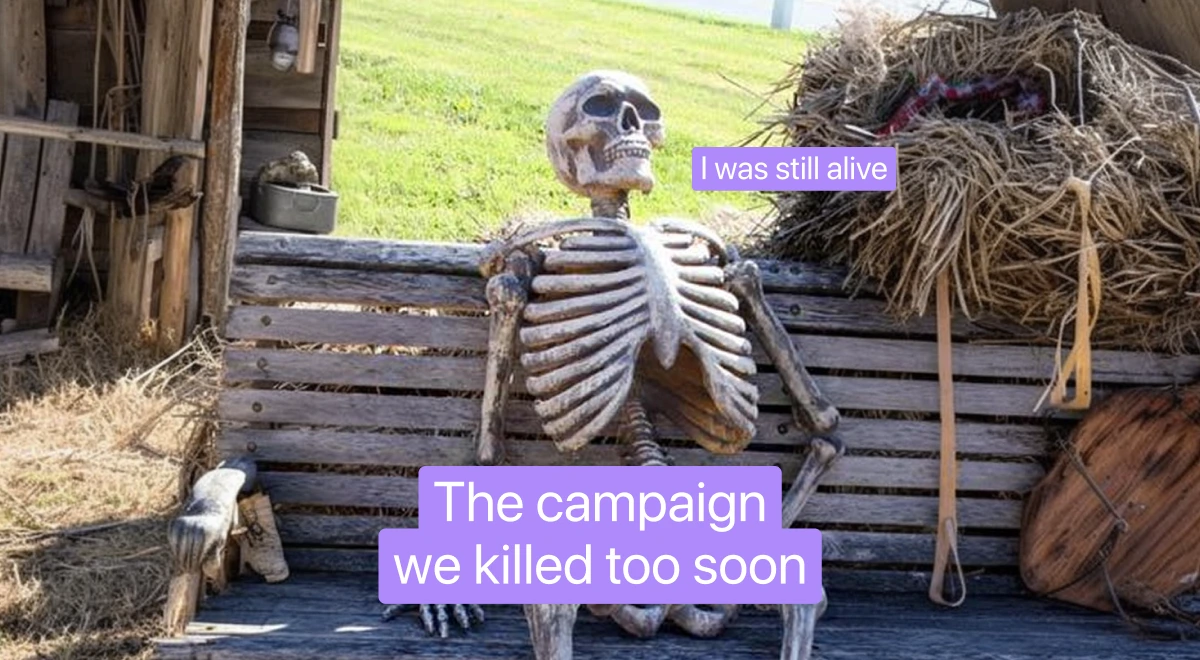
From “let’s scale” to “wait, what’s our LTV?”
By the time this App Studio was ready to scale paid acquisition, the team was already stretched thin. The growth lead was deep in dashboards daily, exporting CSVs from Meta and ASA, pulling trial and sub data from Apphud, decoding Apple receipts, and trying to match it all up inside Google Sheets. “It took me hours just to understand what was going on,” they say. “And sometimes even after those hours, I still wasn’t sure.”
They tracked everything, but nothing was connected. CAC had to be built manually. LTV wasn’t visible until weeks after spend. Even renewal rates came in with a delay. If a cohort dropped or a geo spiked, no one saw it until it was too late to act on it.
Their in-house BI setup was supposed to bridge the gaps, but in practice, it wasn’t built for UA. It could surface revenue trends, but not connect them back to actual campaign decisions. “The BI system showed us revenue, but not performance,” the growth lead explains. “We had numbers, but no decisions. We couldn't see early signals, only results after the fact.”
Apphud was useful, but incomplete. “There was no connection between our campaigns and the users inside Apphud. We could see cohorts, renewals, even predicted LTV, but there was no ad spend. So if we wanted to understand how much a subscriber actually cost, we had to do it manually in Excel. Apphud just didn’t show that part.”
Testing new hypotheses became a drag. Every idea had a 10-tab overhead: download, clean, match, align cohorts, and try to model payback manually.
“Even small tests required huge effort,” they say. “So we tested less.”
And when a campaign looked shaky on day three, it got killed because there was no signal saying it would recover. When something looked okay, it got left running because there was no proof it wouldn’t.
All of it led to a quiet kind of drag in the growth process. UA moved forward, but only within narrow lanes. Every decision had to be double-checked, every test trimmed down to the safest version. The team had experience, clarity of vision, and strong hypotheses, but the setup left no space for fast, confident action.

Spreadsheet out, math model in
At some point, the team decided they’d had enough of spreadsheet archaeology. They needed to stop analyzing past mistakes and start making confident bets in real time. That’s when they connected Campaignswell.
There was no need to build new pipelines or bring in analysts. They simply provided access to the data they were already collecting — spend, trials, subscriptions, receipts — and Campaignswell did the rest.
“Everything just showed up. I wasn’t building dashboards anymore, I was reading them,” says the growth lead.
Behind the scenes, Campaignswell’s ML engine got to work. It powered predictive LTV analytics, analyzing cohort behavior and monetization trends to deliver accurate 12-month revenue forecasts from the very first day. These forecasts are refreshed constantly, every five minutes, as new data rolls in, so if users from six countries made 30 new payments, that was immediately reflected in the model. This level of insight gave the team a clear picture of their app marketing performance and allowed them to act on trends before competitors even noticed them.
And the predictions weren’t vague. They were broken down by geo, creative, and even specific products. Even for new apps with little historical data, the behavior-based modeling was accurate enough to guide real decisions.
So what changed? How did it reshape their workflow? And what kind of results did they actually see?
Let’s hear it from the founder.

Scaling without sweating (finally)
Before Campaignswell, they would open five tabs, fire up Google Sheets, and hope for no formula errors just to understand what happened last week. Today, they start every morning with one dashboard and one habit: checking yesterday’s performance.
“It’s the first thing I do, open up Campaignswell and look at the day before,” they say. “If we overspent somewhere, I see it right away. If something’s off in the weekly view, I can dig in before it becomes a bigger problem.”
Daily and weekly reads now happen in minutes, not half a day. What used to be a chaotic blend of spend reports, trial conversions, and manual CAC tracking is now a clean, predictable loop. If performance looks off, this team can see exactly where the problem is, down to specific geos. “If something’s too expensive, I spot it right away,” they say. “Then I flag it to UA, they open the country breakdown, turn off what’s dragging the whole campaign down, and keep the rest running.”
Before, that level of optimization just wasn’t possible. Now, they can tune campaigns like an equalizer, amplify the strong signals, and cut the noise.
Instead of guessing whether a test should continue, they use Campaignswell to model how it’s trending and project what’s likely to happen next.
They’re already scaling with confidence but still in that early phase of the relationship where you double-check everything, just in case. They compare predicted LTVs from today with what those same cohorts looked like a month ago. They cross-check Campaignswell forecasts with Apphud, especially on apps with longer cycles. Even if predictions change, which they do, based on new user behavior, the team knows what to look for.
Okay, okay, we hear you. Enough suspense, give us the numbers. In February, this App studio was spending around $51.5K/month across channels like Google and Meta. By May, they had ramped up to over $165K/month.
This was no small jump. Historically, they never spent over $60K/month, always pulling back when signals looked shaky. But Campaignswell's real-time view, predictive LTV analytics, and deep insights into app marketing performance gave them confidence:
- They tracked predicted ROI daily, not monthly.
- They checked cohort pLTV before scaling new campaigns.
- They cut underperforming geos instantly, based on day-3 and day-7 behavior.
And crucially, they found that some campaigns they previously paused were actually viable; they just had longer payback windows or were profitable only in specific geos. Campaignswell let them model those scenarios instantly.
You’re thinking it, so we’ll say it: “Cool, but where’s the revenue?” Fair ask. The crew wants to know too, and we’re almost there. Just a few more cycles and we’ll be back with the full post-payback story.
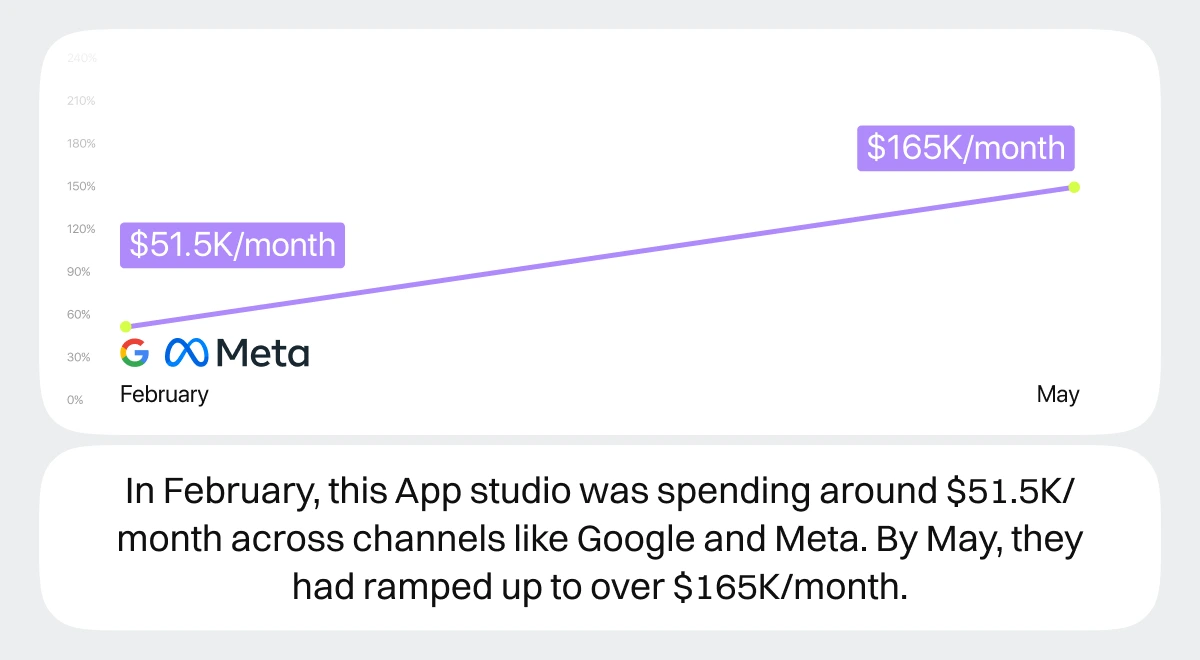
For growth teams who don’t have time to babysit dashboards
Some teams track growth like they’re assembling IKEA furniture: ten tools open, vague instructions, and a sinking feeling they’ve missed a piece.
That was our client. BI showed revenue. Sheets tracked CAC. Apphud handled subscriptions. Useful? Sure. But when it came to making budget calls, nothing told the full story or told it fast enough.
Campaignswell didn’t replace those tools, it made them work together. You connect your ad platforms, your MMP, and monetization data — we build a mathematical model that ties it all together. It picks up early user behavior, links it to revenue patterns, and shows how each cohort is likely to perform over the next 12 months. The predictions update constantly, and they’re already broken down the way you need — by geo, campaign, creative, or product.
From day one, Campaignswell predicts how your cohorts will pay back over 12 months, broken down by geo, campaign, creative, product, and so on. These forecasts update every few minutes based on what users are actually doing, not what they did last quarter.
Even if you’re just starting out and don’t have much historical data, we’ve got you. The system is trained on a massive base of user behavior patterns across verticals. That’s how we can deliver LTV forecasts with over 90% accuracy from the first days of a cohort.
You’ll stop guessing when to kill a campaign or push spend, because you’ll have real-time campaign optimization and reliable app marketing performance data to guide every move. You’ll stop pinging your BI team for a CAC breakdown. You’ll stop pretending your App Store revenue tab counts as forecasting.
If you’ve ever said “we’ll check ROI next month” while approving today’s spend, Campaignswell is what you needed yesterday.
Still making growth calls with yesterday’s spreadsheet?
Book a demo and we’ll show you what it’s like to know before you spend.

Co-founder & CEO at Campaignswell


